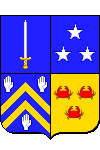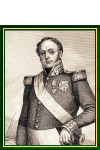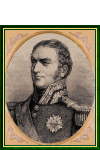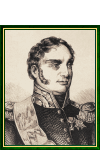Count of the Empire
Pronunciation:

Bertrand Clauzel (sometimes spelled Clausel) was born on September 12, 1772 in Mirepoix , in the future Ariège department, where his father was a cloth manufacturer.
He joined his hometown's national guard in 1789, became a chasseur lieutenant in 1790, and was appointed adjutant general and brigade commander in 1795 in the Pyrenean army, where he had served since 1792. His career continued in the Army of the West, then as chief of staff to Emmanuel de Grouchy Emmanuel de Grouchy in the Army of England in 1798. He was promoted to brigadier general in early 1799, while serving in the Army of Italy.
In 1801, under the command of General Charles Victoire Emmanuel Leclerc, he took part in the Saint-Domingue expedition, capturing Port-au-Prince. In December 1802, he was appointed Major General. He returned to France via New York after a shipwreck off Florida.
The following years were less eventful, with postings in Holland, Italy and Dalmatia keeping him away from the battlefield until the German campaign of 1809.
Clauzel then moved on to Spain, where he was wounded at the battle of Salamanca, before leading the retreat of the French army called the Army of Portugal.
He commanded the Armée du Nord in 1813, then fought under Marshal Jean-de-Dieu Soult at Orthez (February 27, 1814), Aire (March 1), where he was victorious, and Toulouse (April 10).
Louis XVIII made him Inspector General of Infantry and confirmed his title of Count during the First Restoration.
During the Hundred Days, Napoleon made him a Peer of the Empire on June 2, 1815. As commander of the Pyrenées-Occidentales observation corps, Clauzel confronted the royalists in the south-west, then attempted to resist them after Waterloo. As a result, during the Second Restoration, his name was added to the ordinance of July 24, 1815, and he was sentenced to death. More skilful than most, Clauzel escaped arrest and went into exile in the United States.
In 1820, an amnesty allowed him to return to France. After initially living in seclusion in the Toulouse region, he was elected deputy for the Ardennes in 1829.
Louis-Philippe I gave him command of the African Army in 1830, and the marshal's baton the following year. In 1835, Clauzel became Governor General of Algeria, but his failure at Constantine in 1836 and the disastrous retreat that followed cost him his post.
In May 1840, he was appointed rapporteur for the committee in charge of debating a bill to open a million-franc appropriation for the transfer of Napoleon's ashes to the Église des Invalides and for the construction of his tomb. The bill was passed by an overwhelming majority.
Bertrand Clauzel died at his château de Secorrieu (commune of Cintegabelle, Haute-Garonne) on April 21, 1842. He is buried in the Sautadou cemetery in Mirepoix.
"General Clauzel" by Caroline Bertrand born Desforges, after Charles-Émile Callande de Champmartin (Bourges 1797 - La Neuville-en-Hez 1883).

Tasked in 1798 with obtaining the abdication of Charles-Emmanuel IV of Savoy, Clauzel handled the task tactfully enough for the king to offer him a fine painting as a token of his gratitude. The work ("La femme hydropique" by Gerard Dow) must not have pleased the young soldier, who donated it to the Louvre .
Clauzel's name is inscribed on the 34th column (west pillar) of the Étoile triumphal arch .
Other portraits

Enlarge
"General Clauzel". 19th century engraving.

Enlarge
"General Clauzel". 19th century engraving, after Charles-Emile Callande de Champmartin.

Enlarge
"General Clauzel". 19th century engraving.

Enlarge
"Captain Clauzel of the 43rd line in 1792" by Georges Rouget (Paris 1781 - Paris 1869).

Enlarge
"General Clauzel". 19th century engraving.